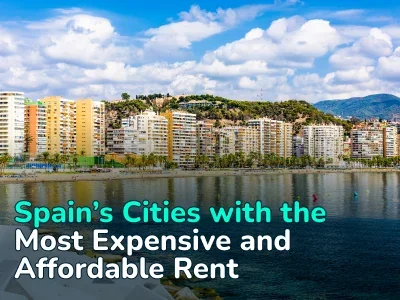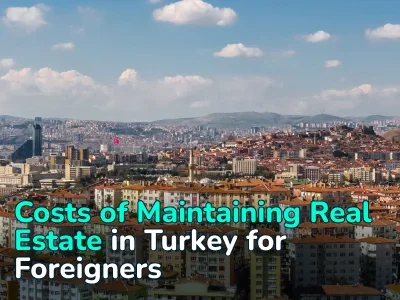
Buying and Selling Real Estate in Italy: All About Taxes and How to Optimize Them
Taxes are an integral part of real estate transactions in Italy. The local tax system regulates all types of property transactions, including not only the purchase and sale but also the simple ownership of housing. Foreigners unfamiliar with Italian taxation often encounter errors in calculating payments, which at best will require additional payments, and at worst will impose fines on the person.
If you dig deeper, it turns out that the local system is full of not the most pleasant nuances. For example, in some cases, taxes are calculated based on cadastral value, and in others, on commercial value, which greatly affects the final amount of payments.
In our article, we will tell you what taxes there are in Italy when buying and selling real estate, as well as how much it costs to maintain it and what pitfalls foreigners encounter most often.
Taxes When Buying Real Estate in Italy
Taxes on buying a home in Italy depend on whether it is a new building or a secondary market property. But even more importantly, whether this is your first home in the country or not.
Registration tax (Imposta di Registro)
Registration tax is paid when purchasing real estate, except in cases where the property is subject to VAT (for example, new buildings from a developer). It is always calculated based on the cadastral value of the property (valore catastale), and not on the actual market price.
A tax of 2% (but not less than €1000) of the cadastral value is applied if the owner uses the property as their main residence (Prima casa). The property must not be luxury, i. e. does not fall into the A/1, A/8, A/9 category in the cadastral register, and the buyer must not own other real estate in Italy acquired under this benefit. To receive it, it is necessary to register residency in the municipality of the property within 18 months of the purchase. Foreigners can do this only if they have a residence permit (permesso di soggiorno).
If at least one condition is not met, for example, residency is not issued on time, then the tax is recalculated according to the indicator for the second home (9%). Then the buyer will have to pay the difference of 7% plus 30% of this amount in the form of a fine. Total — 9-10% of the cadastral value plus a penalty.
A flat rate of €200 applies to property purchases through judicial auctions or in land transactions, and less frequently to standard residential transactions.
The registration tax is taken from the cadastral value (valore catastale), which is usually lower than the market value. The cadastral value is determined by multiplying the cadastral income (rendita catastale) by a coefficient of 115.5 for the first house and 126 for the second. The cadastral income indicator is usually indicated in the property documents.
Tax calculation:
- First house:
- Market price: €150,000.
- Return price: €600.
- Cadastral value: €600 × 115.5 = €69,300.
- Tax: €69,300 × 2% = €1386.
- Total: €1386.
- Second house:
- Market price: €300,000.
- Return price: €800.
- Cadastral value: €800 × 126 = €100,800.
- Tax: €100,800 × 9% = €9072.
- Total: €9072.
VAT (IVA)
Value Added Tax (Imposta sul Valore Aggiunto, IVA) is mainly applied when purchasing new real estate in Italy. It is calculated not on the cadastral value, but on the commercial value of the property (prezzo commerciale), that is, on the amount specified in the purchase and sale agreement.
VAT is charged if the property is sold by a legal entity (for example, a construction company) and is classified as new. But there is a catch: new housing is considered not only new buildings no older than five years, but also objects no more than five years after major repairs. In all other cases, a registration tax is charged.
For the first home, VAT is 4% and is provided under the same conditions as in the case of registration tax:
- The property does not fall into categories A/1, A/8, A/9 (luxury).
- The buyer does not own other real estate purchased under the concession.
- Registration of residency within 18 months (for foreigners with a residence permit).
If the terms are violated, the interest is also recalculated at the standard rate for a second home of 10% with an additional payment of the difference plus a fine of 30% and penalties. The highest VAT rate of 22% is paid for luxury housing. In this case, it does not matter whether it is the first home or the second — the rate will be fixed.
Additional Taxes
When purchasing a property subject to VAT, you also have to pay the mortgage (Imposta Ipotecaria) and cadastral (Imposta Catastale) taxes. These are the fees for registering the property and entering the data into the cadastre. They always go together and depend on the type of transaction, the status of the seller, and whether the prima casa exemption applies or not.
In most cases, they are calculated as a percentage of the cadastral value, but are sometimes replaced by fixed rates:
- Each for €50. Applies when a property is purchased from a private individual (not a company) and the property is classified as a first home.
- Each one €200. Charged when purchasing an object from a legal entity, when the transaction is subject to VAT, regardless of whether the buyer is buying their first home or their second.
In cases of purchasing a second or subsequent property from a private individual, i. e., without VAT, mortgage and cadastral taxes amount to 2% and 1% of the cadastral value.

Taxes on the Sale of Real Estate in Italy
The main tax on the sale of real estate is the capital gains tax (Plusvalenza). Its rate depends on how long the person has owned the property, whether he or she used it as a primary residence, and whether he or she is a resident of Italy.
Capital Gains Tax (Plusvalenza)
Capital gains tax is levied on profits earned domestically and abroad (for residents). In real estate transactions, it is only paid if the owner sells the property for more than it was worth when buying it and within 5 years of the purchase.
When tax does not apply:
- Owned for more than 5 years. Beyond the 5-year holding period, capital gains are exempt from taxation regardless of whether the property was used as a primary residence or not.
- Primary residence. If the seller personally resided in the house for most of the time (more than 50% of the total period of ownership) and this is confirmed by the registration of residence, no tax is levied, even if the sale took place within 5 years.
- Losing trade. If the owner sells the property for less than he bought it for, then no tax is levied because there is no actual profit.
Profit is defined as the sale price minus the original purchase price minus additional expenses. The sale price is taken as the commercial value (prezzo commerciale) from the sales contract. Additional expenses include taxes paid at the time of purchase, notary and agency fees, as well as repair and modernization costs.
The seller can choose one of two options for taxing profits:
- A fixed rate of 26%, which applies to the net profit (Plusvalenza) and is paid through the notary during the sale process.
- The profit is added to the seller’s annual income and is subject to a progressive IRPEF rate, and, depending on the total income, is taxed at a rate of between 23% and 43%. This is a more convenient option, but is only available to Italian residents and requires filing a tax return (Dichiarazione dei Redditi) the following year.
This also results in a difference between residents and non-residents. The former are taxed at a rate of 23% to 43%, and if the total annual income is small, then 23% will be paid from the sale of real estate. Non-residents always pay 26%.

Annual Property Maintenance Taxes in Italy
Owning a property in Italy involves annual tax obligations that depend on the type of property, its use and the status of the owner. The main payments include the real estate tax (IMU) and the waste collection fee (TARI), and in some cases, until 2020, the Tax on Indivisible Services (TASI) was applied, which is now merged with the IMU.
These taxes are calculated based on the cadastral value or area of the property and are paid by all owners, including foreigners, whether they live in Italy or not. This section will help you understand what amounts to expect each year and how to minimize them.
IMU (Imposta Municipale Unica)
IMU is an annual property tax in Italy. It is paid by all owners of buildings, land, and agricultural land, regardless of whether they live in the country or not. The only exception is for tenants — they do not pay IMU, as it is the owner’s responsibility.
The IMU is based on the cadastral value (valore catastale) of the property, and its rate consists of a base rate (aliquota base) of 0.86% (up to 1.06-1.14% in large cities) and a municipal surcharge. The latter varies from −0.46% to +0.28% and can both reduce and increase the base rate. The tax applies to all properties that are not the owner’s primary residence.
Imposta Municipale Unica does not apply to first and main residences (except luxury). The exemption also applies if the property was transferred for free use to first-line relatives (parents, children), and this is their first home.
In other cases, the rate can be reduced by 50% if the local municipality has declared the property unfit for habitation. The rate is reduced by a quarter for properties rented at preferential rates (canone concordato). But this is only available to residents — non-residents always pay the tax at full cost.
TARI (Tassa sui Rifiuti)
Tassa sui Rifiuti is a municipal tax for the removal and disposal of household waste. It applies to residential buildings, apartments, commercial premises, and even empty properties if they have utilities. TARI is calculated based on the area of the property and the number of residents, but the exact rates vary greatly, as it is levied by local communes.
TARI consists of two parts:
- Fixed portion (quota fissa). It is calculated based on the area of the property at approximately €1—3 per m² per year. For commercial real estate, the amount is €5—10 per m².
- Variable part (quota variabile). It is calculated based on the number of residents (nucleo familiare) at a fixed amount of €50—€200 per year per person.
Cadastral and Commercial Value
When calculating taxes, it is important to clearly understand what base they are taken from. The cadastral value of an object is set by the state and is almost always lower than the commercial value. Accordingly, taxes from it will be lower than those calculated from the actual value.
The cadastral value is used to calculate the registration tax (Imposta di Registro), the mortgage and cadastral fee, and the annual real estate tax (IMU). The reason is simple — to protect the population from an increase in the financial burden in the event of a price jump. The state fixes the base on the basis of cadastral income (rendita catastale), which is updated less frequently than market prices, ensuring the stability and predictability of taxes.
Commercial value is used to calculate VAT (IVA) and capital gains tax (Plusvalenza) because these taxes are related to the real economic value of the transaction. VAT reflects the developer’s income from the sale of the new building, and capital gains reflect the seller’s actual profit. Thanks to this, the state can better control the current market situation to fairly distribute the tax burden between the parties to the transaction.
But there is still a basis for speculation. When buying from a private person, you can agree to calculate all taxes only from the cadastral value. The seller may agree to this in order to sell the property faster.
Frequently Asked Questions (FAQ)
What taxes are paid when buying real estate in Italy?
When buying property in Italy, taxes depend on whether you are buying from a private individual or a company, and whether it is your first home (prima casa) or second (seconda casa). If you are buying from a private individual, for example, the main payment is the registration tax (2% for the first and 9% for the second). In addition to this are the mortgage and cadastral fees: €50 each for the first, or 2% and 1% respectively for the second.
Property from a legal entity is subject to VAT (4% for a first home, 10% for a second home, or 22% for luxury properties), plus fixed fees (registration, mortgage, and cadastral) of €200 each.
Do I need to pay tax when selling real estate?
The only tax on sale is capital gains tax, but this only applies if you sell the property for more than you bought it for and do so within 5 years of purchase. It has a flat rate of 26%, but residents can include this in their annual income and pay the IRPEF rate of 23% to 43%, depending on annual earnings.
Is it possible to reduce taxes?
The main way to reduce property taxes in Italy is to get the first home tax exemption. This will reduce the registration tax from 9% to 2%, and VAT from 10% to 4%. If the property is not the first, there is another trick — use the Prezzo-Valore rule when buying from a private individual. The rule allows, by agreement of the parties, to include a clause in the contract that taxes are calculated only from the cadastral value. Considering that the cadastral value is 3-5 times less than the commercial value, taxes are reduced in direct proportion. When selling real estate, you can completely zero out the capital gains tax if you carry out the transaction after five years of owning the property.
Author
I write informative articles about real estate, investments, job opportunities, taxes, etc.























